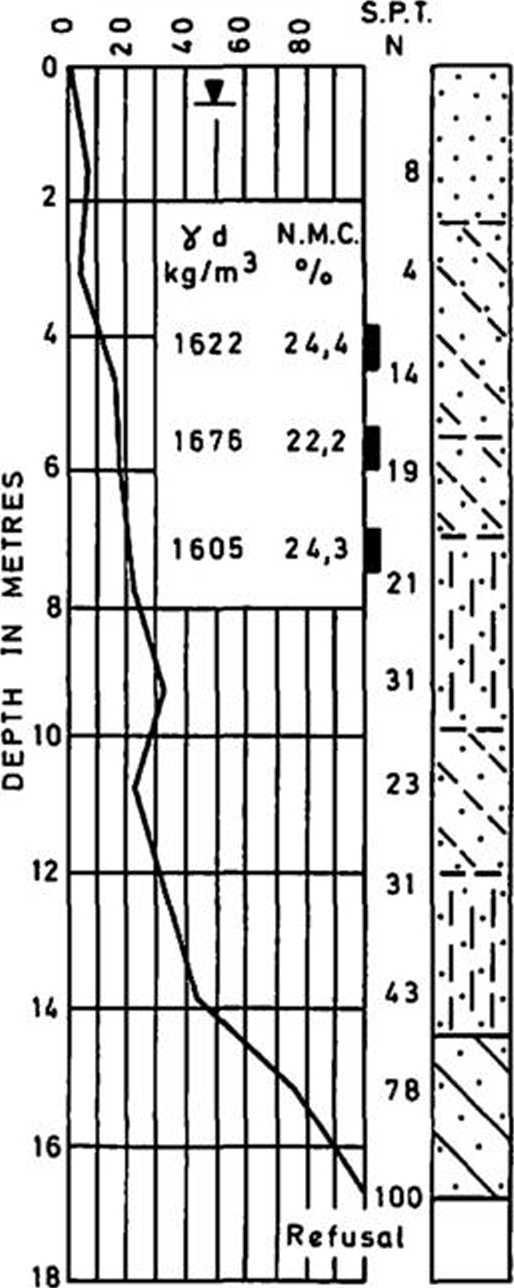6585844992
204
South Africa
PENETRATION
RESISTANCE

DESCRIPTION
Dark brown ioose fine SAND
Dark yellowish brown dense clayey SAND with lenses of sandy ctay
Dark reddish brown dense clayey SAND
Light brown dense fine silty SAND
Light brown mottled grey medium dense fine clayey SAND
Light brown dense fine silty SAND
Yellowish very stiff CLAY
Diameter of Casing 150 mm | LU Tubę Sample
Fig. 2. Results of standard penetration test in estuarine sediments.
lower part of the core the ratę of dis-charge of the drilling fluid is kept to the minimum required for flushing the bit and fluid passages. Drilling fluid com-prising Bentonite in water is generally employed. In some materiale, such as the overconsolidated and partly cemented Cre-taceous silty fine sand, elear water is satisfactory. To prevent contamination of samples which are reąuired for labora-tory testing it is often necessary to use clean water. Borehole casing is generally found necessary for rotary core drilling in soil materiał soft enough for standard penetration testing.
Auger Boring.
Truck mounted helical augers are soraetimes used for putting down boreholes, in con-junction with standard penetration tests, in partly saturated soils above ground-water level, particularly when water in wash borings would otherwise affect their shear strength. Most of the experience in this form of standard penetration testing relates to the moderately dense clay-ey Berea Red sands in the Durban area.
The auger holes are either 150 or 200 mm in diameter and have been advanced to depths of up to 30 m. An advantage of this method is that, although disturbed, representative unsegregated samples of the subsoil materiał at its natural water eontent can be obtained, and ground-water level can be ąuickly and positively es-tablished.
Recording of Test Results.
A representative log sheet on which are recorded the results of standard penetration tests in a wash boring in saturated alluvial sediments is shown in Figurę 2.
In this instance the size of the borehole was large enough to permit U4 samples to be taken, but Shelby tubę and piston sam-j$les are sometimes also taken in conjunc-tion with standard penetration tests.
Apart from the economic factors involved, it is usually found unnecessary to obtain piston samples or larger diameter tubę samples from each borehole in a site in-vestigation, particularly in erratic allu-vial and estuarine deposits. By far the greater proportion of borings are of NX or BX size for Raymond spoon sampling and standard penetration testing only. On larger projects, and in areas where there is little or no prior information on the subsoils, up to ćibout one third of the boreholes would commonly be 150 mm diameter. Results of laboratory indicator tests are sometimes included on the log sheets.
Dynamie Cone Penetration Test.
This test is analogous to the standard penetration test except that the Raymond spoon is replaced by a solid cone 50 mm in diameter with an apex angle of 60 deg-rees. The DCPT blow count is the number of blows reąuired to drive the cone 300 mm
brown
sandy
into the soil under the action of a 63,5 kg weight falling through a height of 750 mm. The drive rods are of smaller diameter than the cone, E size rods of 33,3 mm diameter normally being employed.
Thus in a soil which possesses some cohe-sive strength the friction on the rods may be less than in a soil which closes in around the rods. The cone is dispos-able and when the rods are withdrawn the cone is left in the soil.
The test is usually performed using a truck-mounted mast with a smali motorised winch. The drive hammer runs on a guide rod which is marked at the reąuired height of 750 mm. The winch operator raises the hammer to this mark and then releases the winch, allowing the hammer to drop on to an anvil attached to the E rods. The weight is lined up, by eye, with the mark each time. An automatic trip hammer is not used for DCPT work.
As the drop hammer falls it has to over-come friction in the winch as the cable unwinds and the energy imparted by it to
Wyszukiwarka
Podobne podstrony:
209 South Africa E* = 358(N + 5) kN/ra2 (5) in saturated clayey fine sands. Ratios
Penetration testing in South Africa esoptD.L. Webb State-of-the-
207 South Africa The CBR penetrometer is intended for use where access is difficult for
208 South Africa Fj = Total Shaft Friction q c = Cone Resistance Fig. 5. Results of Dutch static con
210 South Africa The dynamie cone penetrometer has, how-ever, been used fairly extensively to es-tlm
211 South Africa Fig. 8. Evaluation of in Dutch static cone penetration test. (10) ult Flats areas,
296 Sprawozdania i recenzje H. J. Deacon: Notę on the X-ray of two mounted implements from South Afr
BECKLEY (L.E.) 1984 : The ichthyofauna of the Sundays estuary, South Africa, with particular re
1 Physical Sciences NWO-NRF: Cooperation between the Netherlands and South Africa on Astronomy and E
I ntroductionBackground The Netherlands and South Africa have a joint interest in promoting and stre
I ntroductionBackground The Netherlands and South Africa have a joint interest in promoting and stre
62os 6 Lagos, Nigeria. Capc Town, South Africa. Yictoria, Australia. awkłtonc Parli, Englarv
165. Tnc deicgatiom of Bur ma and South Africa arc noc sarisncd that ihc nghts ani interesu of the b
205 South Africa BLOWS PER 300mm o
206 South Africa screwed to the end of a string of solid £lush jointed rods approximately 15 mra
212 South Africa TABLE 3 Bearing Capacity
więcej podobnych podstron